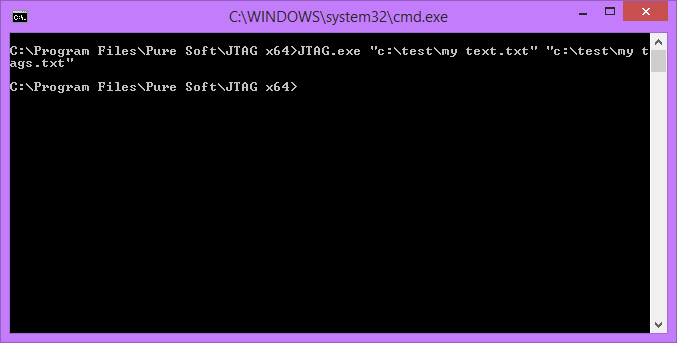راهنمایی API نرم افزار JTAG
به نام خدا
در این مطلب، با آموزش API نرم افزار JTAG در خدمت شما هستیم.
در نسخهی ۳ به بعد نرم افزار JTAG قابلیت API نیز به برنامه اضافه شده است که برنامه نویسان میتوانند از قابلیت ساخت برچسب نرم افزار JTAG در نرم افزار خود استفاده کنند.
برای استفاده از این قابلیت شما باید فایل های نرم افزار JTAG را در یک پوشه قرار دهید. تمام فایل های مورد نیاز نرم افزار در محل نصب نرم افزار قرار دارند. توجه کنید که نام و ساختار این فایل ها را تغییر ندهید. همچنین باید توجه داشته باشید به علت اینکه در حالت خط فرمان از مکانیسم دوم یعنی از برچسب های پیش ساخته استفاده نمیشود نیازی به فایل دیتابیس برچسب های پیش ساخته نیست و شما فقط باید فایل های موجود در محل نصب برنامه را کپی کنید.
حال بوسیلهی Command Line Arguments میتوانید برنامه را اجرا کنید. نرم افزار به دو آرگومان نیاز دارد. اولین آرگومان آدرس یک فایل ترتیبی است که شامل متن اصلی برای ساخت برچسب است. این فایل باید حتماً در مسیر مشخص شده وجود داشته باشد. دومین آرگومان نیز آدرس فایلی است که برچسب ها باید در آن ذخیره شوند. اگر این فایل وجود نداشته باشد، توسط JTAG ایجاد خواهد شد. برای مثال در تصویر زیر مشاهده میکنید که فایلی به نام my text.txt که حاوی متن اصلی برای ساخت برچسب است توسط نرم افزار JTAG باز شده و برچسب های آن در فایل دیگری به نام my tags.txt قرار گرفته اند. فایل دوم یعنی my tags.txt در مسیر مشخص شده موجود نیست، بنابراین توسط JTAG بطور خودکار ایجاد خواهد شد:

نکتهی مهم در اینجا این است که برچسب ها بر اساس تنظیماتی که در قسمت تنظیمات برای برنامه تعریف شده اند ایجاد خواهند شد. از نظر تعداد برچسب و غیره. لذا برای تغییر این تنظیمات بدون باز کردن نرم افزار باید اطلاعات نرم افزار در رجیستری ویندوز را تغییر دهید. برای مثال فایل reg زیر عبارت جدا کنندهی تگ ها را برابر با "," قرار میدهد، حداکثر تعداد حروف یک برچسب را برابر با ۱۴ قرار میدهد، حداکثر تعداد برچسب ها را برابر با ۵ قرار میدهد، حداقل تعداد حروف یک برچسب را برابر با ۴ قرار میدهد و حروف اضافه را از برچسب ها حذف میکند.
Windows Registry Editor Version 5.00 [HKEY_CURRENT_USER\Software\Pure Soft\JTAG\Tagger] "Separator"="," "MaxChar"=dword:00000014 "MaxTag"=dword:00000005 "MinChar"=dword:00000004 "Preposition"="true"
در ادامه یک سورس کد نمونه را مشاهده میکنید که با زبان ++C نوشته شده است و برای ساخت برچسب از API برنامهی JTAG استفاده میکند:
// JTAG API TEST
#include "stdafx.h"
using namespace std;
#define MAX_CONTENT_LEN 1024
int main(int argc, char ** argv)
{
char fmname[_MAX_PATH];// Main text file
char frname[_MAX_PATH];// Result file
char content[MAX_CONTENT_LEN];// Main content
char path_arg[_MAX_PATH] = { 0 };// Path args
// Get Main file path
cout << "Please enter main text file path: " << endl;
cin.getline(fmname, _MAX_PATH);
// Get main content
cout << "Please enter main contents: " << endl;
cin.getline(content, MAX_CONTENT_LEN);
// Get result file path
cout << "Please enter result file path: " << endl;
cin.getline(frname, _MAX_PATH);
// Open main file for writing content to it
FILE * fm = fopen(fmname, "w");
fputs(content, fm);
fclose(fm);
cout << "Content Saved to main file" << endl;
// Create argument for run JTAG with arguments
strcat(path_arg, "JTAG.exe ");// App name
strcat(path_arg, fmname);// main file name
strcat(path_arg, " ");
strcat(path_arg, frname);// result file (Tags will put on this file and its not created)
cout << "Path Arguments: " << path_arg << endl;
// Run JTAG with arguments
system(path_arg);
cout << "JTAG rans" << endl;
// Keep command line open
system("pause");
// Open result file
FILE * fr = fopen(frname, "r");
fgets(content,MAX_CONTENT_LEN, fr);
fclose(fr);
// Show contents of result file
cout << "Result file opened" << endl
<< "Here you can see contents of file: " << endl
<< content << endl;
// Keep command line open
system("pause");
return 0;
}